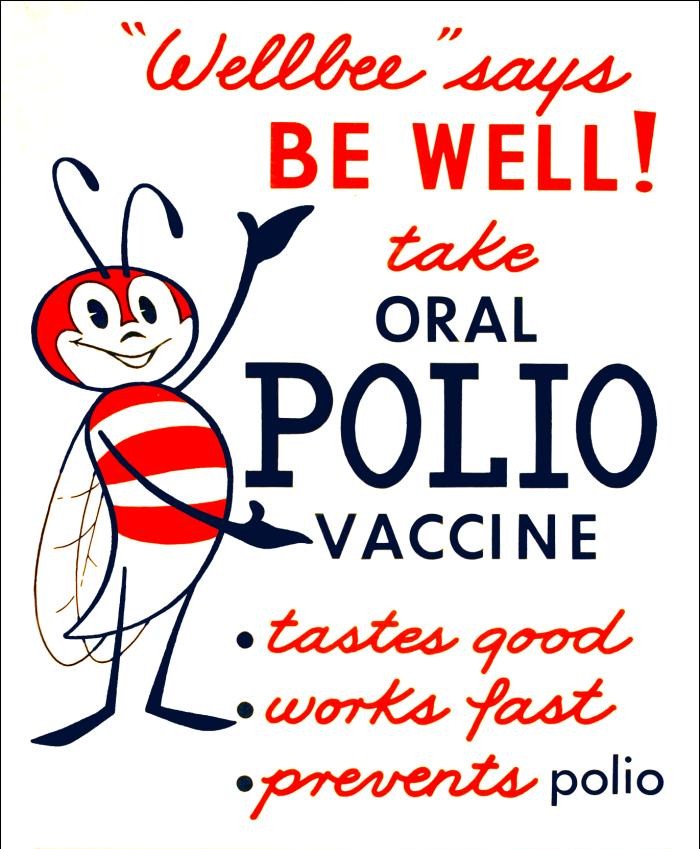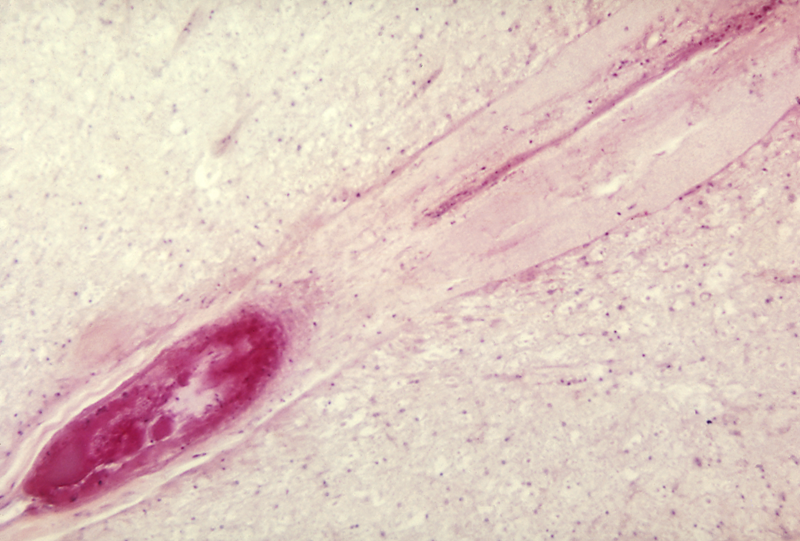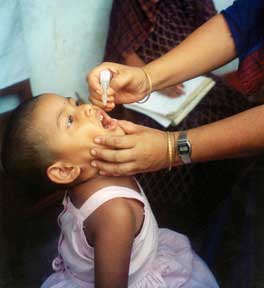|
Polio Vaccine
Polio vaccines are vaccines used to prevent poliomyelitis (polio). Two types are used: an inactivated vaccine, inactivated poliovirus given by injection (IPV) and a attenuated vaccine, weakened poliovirus given by mouth (OPV). The World Health Organization (WHO) recommends all children be fully vaccinated against polio. The two vaccines have eliminated polio from most of the world, and reduced the number of cases reported each year from an estimated 350,000 in 1988 to 33 in 2018. The inactivated polio vaccines are very safe. Mild redness or pain may occur at the site of injection. Oral polio vaccines cause about three cases of vaccine-associated paralytic poliomyelitis per million doses given. This compares with 5,000 cases per million who are paralysed following a polio infection. Both types of vaccine are generally safe to give during pregnancy and in those who have HIV/AIDS, but are otherwise well. However, the emergence of circulating vaccine-derived poliovirus (cVDPV), a ... [...More Info...] [...Related Items...] OR: [Wikipedia] [Google] [Baidu] |
Vaccine
A vaccine is a biological Dosage form, preparation that provides active acquired immunity to a particular infectious disease, infectious or cancer, malignant disease. The safety and effectiveness of vaccines has been widely studied and verified. A vaccine typically contains an agent that resembles a disease-causing microorganism and is often made from weakened or killed forms of the microbe, its toxins, or one of its surface proteins. The agent stimulates the body's immune system to recognize the agent as a threat, destroy it, and recognize further and destroy any of the microorganisms associated with that agent that it may encounter in the future. Vaccines can be prophylaxis, prophylactic (to prevent or alleviate the effects of a future infection by a natural or "wild" pathogen), or therapeutic vaccines, therapeutic (to fight a disease that has already occurred, such as cancer vaccine, cancer). Some vaccines offer full sterilizing immunity, in which infection is prevented. T ... [...More Info...] [...Related Items...] OR: [Wikipedia] [Google] [Baidu] |
Hilary Koprowski
Hilary Koprowski (5 December 191611 April 2013) was a Polish virologist and immunologist active in the United States who demonstrated the world's first effective live polio vaccine. He authored or co-authored over 875 scientific papers and co-edited several scientific journals. Koprowski received many academic honors and national decorations, including the Belgian Order of the Lion, the French Order of Merit and Legion of Honour, Finland's Order of the Lion, and the Order of Merit of the Republic of Poland. Koprowski was the target of accusations in the press related to the " oral polio vaccine AIDS hypothesis", which posited that the AIDS pandemic originated from live polio vaccines developed by Koprowski in the Belgian Congo. This hypothesis was challenged on numerous grounds, and scientists largely rejected it. Life Hilary Koprowski was born in Warsaw to an educated, assimilated Jewish family. His parents met in 1906 when Paweł Koprowski (1882–1957) was serving in t ... [...More Info...] [...Related Items...] OR: [Wikipedia] [Google] [Baidu] |
Poliomyelitis
Poliomyelitis ( ), commonly shortened to polio, is an infectious disease caused by the poliovirus. Approximately 75% of cases are asymptomatic; mild symptoms which can occur include sore throat and fever; in a proportion of cases more severe symptoms develop such as headache, neck stiffness, and paresthesia. These symptoms usually pass within one or two weeks. A less common symptom is permanent paralysis, and possible death in extreme cases.. Years after recovery, post-polio syndrome may occur, with a slow development of muscle weakness similar to what the person had during the initial infection. Polio occurs naturally only in humans. It is highly infectious, and is spread from person to person either through fecal–oral transmission (e.g. poor hygiene, or by ingestion of food or water contaminated by human feces), or via the oral–oral route. Those who are infected may spread the disease for up to six weeks even if no symptoms are present. The disease may be diagnosed by ... [...More Info...] [...Related Items...] OR: [Wikipedia] [Google] [Baidu] |
Polio Vaccine Poster
Poliomyelitis ( ), commonly shortened to polio, is an infectious disease caused by the poliovirus. Approximately 75% of cases are asymptomatic; mild symptoms which can occur include sore throat and fever; in a proportion of cases more severe symptoms develop such as headache, neck stiffness, and paresthesia. These symptoms usually pass within one or two weeks. A less common symptom is permanent paralysis, and possible death in extreme cases.. Years after recovery, post-polio syndrome may occur, with a slow development of muscle weakness similar to what the person had during the initial infection. Polio occurs naturally only in humans. It is highly infectious, and is spread from person to person either through fecal–oral transmission (e.g. poor hygiene, or by ingestion of food or water contaminated by human feces), or via the oral–oral route. Those who are infected may spread the disease for up to six weeks even if no symptoms are present. The disease may be diagnosed by ... [...More Info...] [...Related Items...] OR: [Wikipedia] [Google] [Baidu] |
Share Of One-year-olds Vaccinated Against Polio (Pol3), OWID
Share may refer to: * Share, to make joint use of a resource (such as food, money, or space); see Sharing * Share (finance), a stock or other financial security (such as a mutual fund) * Share, Kwara, a town and LGA in Kwara State, Nigeria Share may also refer to: Arts, entertainment, and media * ''Share'' (2015 film), a short drama film * ''Share'' (2019 film), a feature drama film * ''Share'' (newspaper), a newspaper in Toronto, Canada * Ratings share, percentage of television sets in use tuned to a program, according to the Nielsen Ratings Computing * share (command), a shell command * SHARE (computing), a user group for IBM mainframe computers * Share (P2P), a Japanese P2P computer program, the successor to Winny * Share, a software service of Acrobat.com used for sending files * File sharing * Network share, a file storage area that is available over a computer network * Share icon, a user interface icon intended to convey performing a share action * SHARE Operating ... [...More Info...] [...Related Items...] OR: [Wikipedia] [Google] [Baidu] |
Number Of CVDPV Cases
A number is a mathematical object used to count, measure, and label. The most basic examples are the natural numbers 1, 2, 3, 4, and so forth. Numbers can be represented in language with number words. More universally, individual numbers can be represented by symbols, called ''numerals''; for example, "5" is a numeral that represents the number five. As only a relatively small number of symbols can be memorized, basic numerals are commonly organized in a numeral system, which is an organized way to represent any number. The most common numeral system is the Hindu–Arabic numeral system, which allows for the representation of any non-negative integer using a combination of ten fundamental numeric symbols, called digits. In addition to their use in counting and measuring, numerals are often used for labels (as with telephone numbers), for ordering (as with serial numbers), and for codes (as with ISBNs). In common usage, a ''numeral'' is not clearly distinguished from the ''numb ... [...More Info...] [...Related Items...] OR: [Wikipedia] [Google] [Baidu] |
Contact Immunity
Contact immunity is the property of some vaccines, where a vaccinated individual can confer immunity upon unimmunized individuals through contact with bodily fluids or excrement. In other words, if person "A" has been vaccinated for virus ''X'' and person "B" has not, person "B" can receive immunity to virus ''X'' just by coming into contact with person "A". The term was coined by Romanian physician Ioan Cantacuzino. The potential for contact immunity exists primarily in "live" or attenuated vaccines. Vaccination with a live, but attenuated, virus can produce immunity to more dangerous forms of the virus. These attenuated viruses produce little or no illness in most people. However, the live virus multiplies briefly, may be shed in body fluids or excrement, and can be contracted by another person. If this contact produces immunity and carries no notable risk, it benefits an additional person, and further increases the immunity of the group. The most prominent example of contac ... [...More Info...] [...Related Items...] OR: [Wikipedia] [Google] [Baidu] |
Endemic (epidemiology)
In epidemiology, an infection is said to be endemic in a specific population or populated place when that infection is constantly present, or maintained at a baseline level, without extra infections being brought into the group as a result of travel or similar means. The term describes the distribution of an infectious disease among a group of people or within a populated area. An endemic disease always has a steady, predictable number of people getting sick, but that number can be high ('' hyperendemic'') or low (''hypoendemic''), and the disease can be severe or mild. Also, a disease that is usually endemic can become epidemic. For example, chickenpox is endemic in the United Kingdom, but malaria is not. Every year, there are a few cases of malaria reported in the UK, but these do not lead to sustained transmission in the population due to the lack of a suitable vector (mosquitoes of the genus '' Anopheles''). Consequently, there is no constant baseline level of malaria inf ... [...More Info...] [...Related Items...] OR: [Wikipedia] [Google] [Baidu] |
Intestine
The gastrointestinal tract (GI tract, digestive tract, alimentary canal) is the tract or passageway of the digestive system that leads from the mouth to the anus. The tract is the largest of the body's systems, after the cardiovascular system. The GI tract contains all the major organs of the digestive system, in humans and other animals, including the esophagus, stomach, and intestines. Food taken in through the mouth is digested to extract nutrients and absorb energy, and the waste expelled at the anus as feces. ''Gastrointestinal'' is an adjective meaning of or pertaining to the stomach and intestines. Most animals have a "through-gut" or complete digestive tract. Exceptions are more primitive ones: sponges have small pores ( ostia) throughout their body for digestion and a larger dorsal pore ( osculum) for excretion, comb jellies have both a ventral mouth and dorsal anal pores, while cnidarians and acoels have a single pore for both digestion and excretion. The human gas ... [...More Info...] [...Related Items...] OR: [Wikipedia] [Google] [Baidu] |
Humoral Immunity
Humoral immunity is the aspect of immunity (medical), immunity that is mediated by macromolecules – including secreted antibodies, complement proteins, and certain antimicrobial peptides – located in extracellular fluids. Humoral immunity is named so because it involves substances found in the humorism, humors, or body fluids. It contrasts with cell-mediated immunity. Humoral immunity is also referred to as antibody-mediated immunity. The study of the molecular and cellular immunity, cellular components that form the immune system, including their function and interaction, is the central science of immunology. The immune system is divided into a more primitive innate immune system and an acquired or adaptive immune system of vertebrates, each of which contain both humoral and cell (biology), cellular immune elements. Humoral immunity refers to antibody production and the coinciding processes that accompany it, including: Th2 activation and cytokine production, germinal center ... [...More Info...] [...Related Items...] OR: [Wikipedia] [Google] [Baidu] |
Immunity (medical)
In biology, immunity is the state of being insusceptible or resistant to a noxious agent or process, especially a pathogen or infectious disease. Immunity may occur naturally or be produced by prior exposure or immunization. Innate and adaptive The immune system has Innate immune system, innate and Adaptive immune system, adaptive components. Innate immunity is present in all metazoans, immune responses: inflammation, inflammatory responses and phagocytosis. The adaptive component, on the other hand, involves more advanced lymphocyte, lymphatic cells that can distinguish between specific "non-self" substances in the presence of "self". The reaction to foreign substances is etymologically described as inflammation while the non-reaction to self substances is described as immunity. The two components of the immune system create a dynamic biological environment where "health" can be seen as a physical state where the self is immunologically spared, and what is foreign is inflammat ... [...More Info...] [...Related Items...] OR: [Wikipedia] [Google] [Baidu] |




